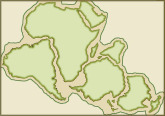
The Tour of Gondwana
A Global Bicycle Journey
With a Southern Disposition
by Michael Ayers
~Thoughts of Gondwana~
Forty months on Tour provide one with plenty of time to ponder a variety of matters. Here is a collection of articles whose subjects occupied my mind while cycling along those long, dusty roads.
Part 1: Tour Essentials
The Plan vs. Reality ~Go there~
I had several years available in which to plan for every conceivable circumstance that might arise on a long tour. How well did I do?
Gear Reviews ~Go there~
What worked, what didn't; what lasted, what vaporized; what saved the day, and what made me shout curses to the gods of cycling.
Charts & Graphs ~Go there~
Strictly for readers who have too much free time on their hands. Graphical representations of the Tour's geographic data, expenses, and much more.
Stay Healthy on a Long Tour ~Go there~
Here's a tip: You can't. At least not all the time.
My Favorite Roads for Touring ~Go there~
There were plenty from which to choose. Also includes selections from all of my previous tours.
See the Pizza Collage! ~Go there~
Amazing! Colossal!! Stupendous!!!
Fragments of Gondwana ~Go there~
Pointless trivia, witty observations, cultural oddities, and any other items that don't belong anywhere else.
Part 2: Natural & Cultural Gondwana
The Flora & Fauna of Gondwana
The lands, waters, and skies of Gondwana provide ample opportunites to observe the other life with which we share the Earth, one of my favorite subjects.
Leafy Gondwana ~Go there~
Furry Gondwana ~Go there~
Scaly Gondwana ~Go there~
Poly-Legged Gondwana ~Go there~
Feathered Gondwana ~Go there~
The Great Gondwanan Ocean ~Go there~
An immense body of water without peers in terms of importance to human history.
Following the Beagle ~Go there~
Unintentionally, the Tour route included many locations previously visited by a very famous ship.
World Heritage Scorecard ~Go there~
One of my secondary goals of the Tour was to visit as many UNESCO World Heritage Sites as possible. I think I did rather well.
Bikes of the World ~Go there~
I had not realized that I would see so many distinctive and classic machines during the Tour.
By Women's Hands ~Go there~
An ancient craft is kept alive and well, primarily by the Ladies of Gondwana.
Art of the Ages ~Go there~
The countries of the Tour are great places to see fascinating examples of mysterious, beautiful, and ancient images.
Cities of Stone ~Go there~
Many countries of the Tour once contained perhaps the finest examples human settlements, some on an impressively grand scale.
Part 3: Gondwana -
The Grand Perspective
Gondwana's Climate Threat ~Go there~
Gondwana may face a grim future as the climate continues to change.
Yes to Currency Equity ~Go there~
An idea sure to ruffle a few feathers, but more relevant today than ever.
Let Kids Be Kids ~Go there~
Certainly an even more controversial idea: Don't give them anything.
The Scourge of History ~Go there~
Gondwana is still recovering from its dreadful period of exploitation. Let's not repeat the mistakes of the past.
The Street Guys ~Go there~
Conventional wisdom may tell you that the world is a wicked place. Don't believe it.
Seek Out Diversity; Appreciate Similarities; The World is One Family ~Go there~
After so much time and distance, my true motivation for the Tour can be revealed.

Main Index
Pre-Tour
Post-Tour
|
Where is Gondwana?
To answer that question requires a brief refresher course in Plate Tectonics for those that are not familiar with that, literally, groundbreaking subject. I have always considered plate tectonics to be one of the most impressive achievements of 20th century scholarship, and it is partly for that reason that I chose the pieces of Gondwana as the destination for my global tour. To get a feel for the concept, allow your perception to expand well beyond that which is necessary in our daily lives, and imagine the Earth as it was 300 million years before today, in the Late Carboniferous period.
At that time, all of the major land masses of the Earth were joined together in a giant continent that has been given the name Pangea. There was only one continent, and one huge ocean. Now, skip forward another 150 million years to the Late Jurassic period, when strange and wonderful creatures filled every liveable space on the planet. Pangea had begun to gradually split in two. The northern part, which has been given the name Laurasia, would later break up further, creating modern North America and most of Eurasia. The large southern portion contained the lands that would eventually become modern South America, Africa, India, Antarctica, and Australia, as well as the Arabian peninsula, Madagascar, Sri Lanka, New Guinea, Tasmania, and New Zealand. That vast terrain was Gondwanaland.

Gondwanaland;
~150 Million years ago.
The name derives from the Gondi people of central India. They live in a region known as Gondwana. It was there that geologists first identified the rocks that would reveal the conjoined past of the southern continents . A trained geologist, which I am not, can easily spot the kinships of the modern Gondwanan fragments. I enjoy looking for other links, however. Due to its long isolation, a unique ecosystem evolved on Gondwanaland which, even today, bonds the lands together. Marsupials and the flightless birds of the ratite family are faunal examples, while floral links can be seen in forests of southern beech, tree ferns, and baobabs. Looking for these types of relationships on widely scattered lands is one of my favorite adventures.
Additionally, as I have seen more of the world I have come to hold the opinion that the so-called "undeveloped" regions of the world are culturally more attractive than the greedy "West". I would even go as far as to say that instead of them trying to emulate our lifestyles, it should be the other way around. Therefore, for me there could be no other destination than the offspring of Gondwanaland.